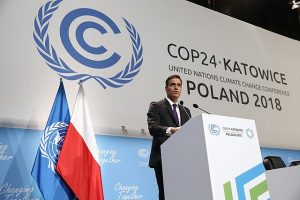December 2018 – Volume 20, Issue 9
In This Issue
The State of Recycling: A Special Report
California Wildfires
“We Mean Business” – COP 24
EcoMotion and SBCCOG Win SolSmart Solicitation
One Million EVs and Counting!
Travelogue: DC Reflections

Flanigan’s EcoLogic: The Recycling Mess
Recycling in America is a mess. The two experts I interviewed for this piece, “could not agree more” with that statement. I don’t know what to throw into my grey, recycling tote. I’m not alone, most people are confused about what’s accepted. Which of the nine forms of plastic are accepted by your local recycling program? Does your city take compost?
Frankly, I’ve let recycling slip out of my sights. But taking a look at it over the past few weeks, yes, recycling is a mess. Thanks to long-time EcoNet reader, George Reis, for flagging this and asking EcoNet for clarification.
In America, we divert about a third of our waste, a rate that has been stagnant for the past 3 – 4 decades. Leading states include California, New York, Massachusetts, Florida, Oregon, and Washington. America suffers from a balkanized recycling stance: There are some 9,800 different programs with different rules across the country. Nothing is standardized. As a result, there is widespread confusion, contamination, and a stagnant national recycling rate.
A major factor in U.S. recycling is single stream recycling… a system adopted in many states that is based on the premise that the public is hapless and will never do a good job of sorting recyclables… and that they need to just throw it all together. That leads to consumers burdening the recycling stream with non-recyclable materials. The mixed collection creates a false positive for the public. Consumers think they no longer have responsibility for what they shop for and what they buy, any consumer guilt assuaged by a hefty load in the recycling tote.
Kreigh Hampel is the director of recycling for the City of Burbank, California. He’s left me with an image… an image of the conveyor belt at his center. A mountain of “recyclable” material the size of a two-story house feeds the line where workers pick and sort. Kreigh says that the conveyor belt never stops, workers on the line run a marathon every day, with a million pulls every day grabbing bottles, cans, cardboard, and more and more plastics. There’s been an escalation in complexity of materials… and as a result, what’s left over at the end of the line, the “residuals” rise.
After researching the issue, I am alarmed, discouraged. And I resolve to tighten my own act… to buy durable, to avoid packaging, and to increase practices of re-use and re-purposing. Furthermore, I am no longer going to be part of the contamination problem that stymies the system. And beyond personal actions it’s time for us all to get active on this issue… to demand manufacturer responsibility for what become our gross wastes, to seek means to harmonize the recycling systems in our country, and to make it simple and effective. Join me.
Quote of the Week
“Imperfect is the understatement of the century for U.S. recycling.”Brian Thurston, former Waste Management official
The State of Recycling: A Special Report
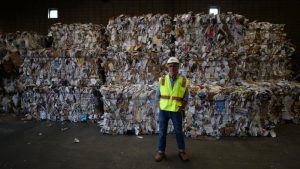
Kreigh Hampel stands in front of material to be recycled in the Burbank, CA recycling center
My good friend and EcoNet reader, Brian Thurston, worked for Waste Management for eight years. He’s a solid waste expert now directing his attention to the collection and reuse of ocean plastics. “Imperfect is the understatement of the century for recycling,” he affirms without hesitation. Not only do we have many dissimilar programs, but packaging includes more materials stuck together, and many of us resort to “aspirational recycling.” That’s the habit of throwing non-recyclable materials into a bin because they might or should be recycled.
Recycling in California: CalRecycle, technically the California Department of Resources Recycling and Recovery is housed within the California Environmental Protection Agency. Best known for its highly successful beverage container laws, CalRecycle is also responsible for electronic waste recycling, organics management, used tires, used motor oil, carpet, paint, mattresses, rigid plastic containers, newsprint, construction and demolition debris, medical sharp waste, household hazardous waste, and food-scrap composting.
In 2011, California set a goal in AB 341 of 75% recycling by 2020. AB 341 also mandated recycling in commercial and apartment buildings with five or more units. In 2016, California generated 76.5 million tons of solid waste and sent 35.2 million tons to landfills. Using a strict protocol for accounting – specifically netting out green wastes used for daily cover as well as solid waste used as fuel — California’s recycling rate was 44%, above the national 34.6% recycling rate, but far short of its goals.
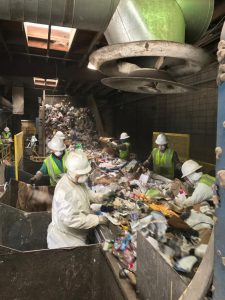
Burbank, CA recycling center
CalRecycle is focused now developing more solutions for plastics that are 25% of the waste stream and food waste (18%). Organics is the next frontier for recycling. Organics about one third of the waste stream. Capturing organics is key to mitigating GHG emissions by reducing short-lived climate pollutants, notably methane. CalRecycle explains that, “When landfilled, organic waste – materials such as leaves, grass, agricultural crop residues, and food scraps – generates methane, a super pollutant with a heat trapping effective about 80 times greater than carbon dioxide.” SB 1383 calls for 50% reduction in statewide disposal of organic waste from 2014 levels by 2020, and 75% by 2025. The law also established an additional target that not less than 20% of currently disposed edible food is recovered for human consumption by 2025.
The Chinese National Sword: In 2016, two-thirds of the recycled materials from California was exported to foreign counties for recycling and remanufacture. Thus, California has been vulnerable to fluctuating global commodity market. In 2016, California exported 15 million tons of recyclable materials, of which 62% went to China. Then China announced the National Sword, a policy that banned 24 recycled materials from entering the country, including unsorted mixed paper and plastic. The policy also limited contamination to 0.5% and increased enforcement.
Kreigh notes that while the radical change in China’s policies sent shock waves throughout the recycling industry, there may be some positives too… things like bans on plastic disposables, more re-use programs, and more producer responsibility. Kreigh has worked with the California Product Stewardship Council and its efforts to prepare mattresses, carpets, brake pads, pharmaceuticals, etc. for recycling. We need to legislate responsibility upstream. It works in Germany, in Japan, in South America, and a host of other countries.
Effective Recycling Programs: What drives effective recycling programs? Those parts of the country that are short on landfill space, generally have high landfill tipping fees. This incentivizes recycling and spurs regional activity. Deposit bills for bottles and cans work like a charm, but they only exist in 12 states. And even in places that have bottle bills, there’s widespread consumer confusion on the rest of the waste stream. Brian lives in Manhattan Beach that has one set of recycling rules… based on its waste hauler and its collection point. Across the street is Hermosa Beach with a different trash company and a different set of recycling requirements. Recycling needs to be standardized.
Recycling Stream Contamination: The garbage truck full of recyclable materials arrives at the recycling center to be sorted. There’s a conveyor belt with workers picking materials and sorting out glass, cans, paper, etc. What’s left is residual material. Burbank has taken 2 – 3 times as much residual materials to landfills in the last 2 – 3 years. Five years ago 7% residual was a good rate; now Burbank is experiencing a 16 – 17% rate of residuals for residential and 22% for commercial. Examples of residuals include plastic buckets with wire bale handles, black or orange hard plastic, and toys.
Part of California’s challenge today is contamination of the recycling stream. This may be the result of single-stream recycling. Instead of having citizens sort their recyclables, policymakers chose to offer single stream. Easy… but highly problematic. Single stream has resulted in higher diversion rates, but at the expense of higher levels of contamination. Brian tells me about wet and dry. While recycling centers can address single-stream recycling pretty well, throw in a few bottles of unused soda and an entire truck’s recycled cargo can be considered contaminated… and that means dumping the entire truck load, losing the value of its recyclables.
The recyclables once sorted are ready to be shipped to markets. And this is where contamination of the sorted materials is problematic. For decades U.S. recycling centers got away with 5 – 20% contamination. Kreigh says that this is normal. Invariably, you sell a bale of paper and in it you get totally random stuff… a sweater, fish heads, a dead cat. That was OK for years as recyclables enjoyed the cheap back-hauling rates to China, filling empty containers on ships headed west to China. Then a sudden jump: China switched from taking everything to raising its standards to a maximum to a 0.5% contamination rate. Kreigh notes that his Burbank facility would go broke if it tried to get its contamination rates below 6%. Some materials that are more easily sorted and controlled, like cardboard and paper, and are still viable on the global market.
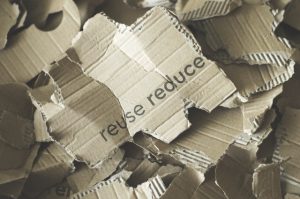 We really want to fill our recycling bins. But if you buy a new set of headphones, the packaging may be made of eight types of materials. Perhaps only two are allowed by your recycler. But not knowing which one is allowed, and which one isn’t allowed, you pitch all the packaging into the bin and hope for the best. Well, that doesn’t work.
We really want to fill our recycling bins. But if you buy a new set of headphones, the packaging may be made of eight types of materials. Perhaps only two are allowed by your recycler. But not knowing which one is allowed, and which one isn’t allowed, you pitch all the packaging into the bin and hope for the best. Well, that doesn’t work.
Holiday Wrapping Paper: During the holidays, wastes always go up. So… can we recycle wrapping paper? Unfortunate answer: It depends: If it is glossy, stripped, fuzzy, laminated, speckled, glossy… then no, it cannot be recycled. Ribbons are synthetic and are out. Foils and sparkles are out too. But if the wrapping paper is simple — just ink and paper — that’s OK to recycle. Confusion.
There are options to wrapping paper. I like used newspapers and magazines to wrap gifts. Some buy or make re-usable cloth gift bags. Things can be tastefully wrapped in bandanas; other solutions are even more creative, like using socks to “wrap” small gifts, like rings.
Recycling Solutions: As a society, let’s examine our pyramid of priorities. We got the order right with the slogan “Reduce, Reuse, Recycle.” But in practice, we only recycle, and not very well to boot! We need to focus on reducing waste and using durable packaging and products. We need to focus on re-use, repurposing materials considered wastes. Urban Ore is a private enterprise in Berkeley enabled by a vision coupled with Alameda County’s steep tipping fees at its landfills. Urban Ore began by taking valuables out of the waste stream. It repurposes high-value wastes.
Kreigh speaks of design solutions such as dishwashers he envisions that are fast and effective and that could put Dixie cups out of business. Speaking out is important too. While industry trade groups believe that recycling is not the responsibility of producers, packaging councils need to feel more heat. Retailers and manufacturers need more feedback on packaging.
As consumers, we have to get back to basics, to shop carefully, to avoid laminated cartons and colorful packaging made with mixed materials. We need to buy more durable goods, and to keep things local by shopping at farmers markets; to avoid excessive packaging. The plethora of meal kits – like Blue Apron – is causing a new waste stream complete with gel packs, insulation, and all sorts of micro-packaging. I was alarmed to learn about “fast fashion,” a trend whereby young professionals are buying low-cost, single-use clothing.
California Wildfires
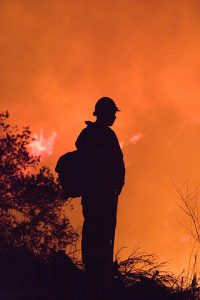 The wildfires in California are alarming manifestations of climate change, potentially a chronic utility problem. Five of California’s largest wildfires have occurred in this decade. This new normal of ravaging fires is fueled by extremely dry conditions, intense winds, and is resulting in entire towns being demolished. Paradise lost 8,000 homes in a matter of minutes. San Francisco, for a time, had the worst air quality in the world. Last year we witnessed fire ripping through the bedroom community of Santa Rosa.
The wildfires in California are alarming manifestations of climate change, potentially a chronic utility problem. Five of California’s largest wildfires have occurred in this decade. This new normal of ravaging fires is fueled by extremely dry conditions, intense winds, and is resulting in entire towns being demolished. Paradise lost 8,000 homes in a matter of minutes. San Francisco, for a time, had the worst air quality in the world. Last year we witnessed fire ripping through the bedroom community of Santa Rosa.
While we mourn the dead and are shocked by the harsh personal losses, this is a time of reckoning. It may well be that aging utility infrastructure, failures, and unusually brittle, drought-ravaged woods, caused the fires. The wildfire realty is stark: Pacific Gas and Electric has already considered bankruptcy after it was implicated in the Santa Rosa fire. It has also filed for the right to shut down its lines preventatively. How many times a year will that be? Can society accept this and simply be without power at times?
Utilities are not only natural monopolies but are among the remaining monopolies in our country. In exchange for exclusivity within a territory, they have accepted the “obligation to serve.” This obligation never has been subject to fine print, like “in the event of a high wind event we no longer stand by this obligation.” Our society can’t have “fair weather utilities.” Instead, utilities need to step up and continue to deliver despite heat or wind. Or might we buy power with varying levels of reliability?

Governor Jerry Brown signed legislation in September giving utilities some relief for some $10 billion in 2017 losses, protects them, but not from the 2018 fire season that proved to be the most destructive in California history. This year, the president of the California Public Utilities Commission said that he is going to protect PG&E from bankruptcy. But how many times will fires destroy billions of dollars of property… and be absorbed by ratepayers? Will each utility-initiated fire cost ratepayers a few cents per kWh more? Ratepayer advocates have vowed to fight this tooth and nail, claiming that the utilities deferred maintenance.
I suspect that our power systems planners have the answers… that the power system can indeed be “hardened…” just as mission critical facilities have. They may need to be designed to withstand intense heat and winds. Infrastructure improvements will be costly but are essential. Concurrently, we are in the midst of a major transformation to a future pronounced by distributed generation. By keeping power generation local, we need not rely on vulnerable high voltage transmission lines. Microgrids demonstrate resilience.
California is one of two states that hold electric companies entirely liable for damage caused by their equipment… even if they followed all safety precautions. The Camp Fire caused PG&E’s stock value to drop by a third. The Woolsey Fire in Ventura, which spread to Malibu and destroyed hundreds of homes, caused shares in Edison International to drop by 20%. Now all the State’s utilities are seeking permission for preventive shutdown of their transmission systems. SCE is pushing the State to enact fire-smart building codes, particularly in high-risk areas.
“We Mean Business” – COP 24
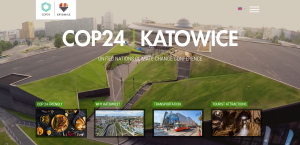 The reports from Poland are encouraging; experts expected far-weaker results. Nearly 200 governments came together in Katowice, Poland for the 24th Conference of Parties and breathed life into the Paris Agreement, developing a roadmap for action. While they failed to adopt the United Nation’s latest findings or to make a stronger push for faster emissions cuts, given this moment of deep global division the Katowice deal was heralded as a victory for multinationalism. GHGs are rising around the world, three years after the landmark climate agreement in Paris. As a global society we are still far from preventing severe global warming in the decades ahead.
The reports from Poland are encouraging; experts expected far-weaker results. Nearly 200 governments came together in Katowice, Poland for the 24th Conference of Parties and breathed life into the Paris Agreement, developing a roadmap for action. While they failed to adopt the United Nation’s latest findings or to make a stronger push for faster emissions cuts, given this moment of deep global division the Katowice deal was heralded as a victory for multinationalism. GHGs are rising around the world, three years after the landmark climate agreement in Paris. As a global society we are still far from preventing severe global warming in the decades ahead.
Katowice began with two big announcements… first the Inter IKEA Group pledged to cut carbon from production processes by 80% in absolute terms by 2030 from 2016 levels. Then Maersk – the world’s largest shipping container company – pledged to cut carbon emissions to zero by 2050. This Danish group transports nearly one in five of the world’s seaborne containers.
The COP 24 deal was struck after an all-night negotiating session; nearly 200 countries adopted detailed set of rules to implement the pact that makes clearer how the richer countries are expected to help poorer nations. COP 24 defined the rules with which Paris will be put in action, balancing between major countries responsible for most emissions, and developing countries wary of being saddled with a bigger burden to act. The U.S. agreed to the deal even though Trump has pledged to back out of the Paris agreement. (The U.S. cannot formally withdraw until late 2020.)
The We Mean Business Coalition showed up in force at Katowice, in the heart of the Polish coal industry. We Mean Business, a host of multinational companies – including shipping giant Maersk, power utility Iberdrola, Indian industrial major Mahindra Group, world’s largest furniture manufacturer – IKEA, “showed up in force in Katowice to deliver a resounding message to policy makers: Business is acting on climate change.” Nigel Topping, CEO of the Coalition that also includes Schneider Electric, Microsoft, SUEZ group, Mars and Unilever, stressed the importance of giving national governments the clear signal of commitment of business to a zero-carbon future. His group wants bold policies – as well as actionable and transformative regulations – to meet the Paris Agreement.
Heavy emitters are embracing the climate protection challenge. Dalmia Cement earlier this year committed to be net positive carbon by 2040. “Policy makers should return from COP with one clear message from business – an increased in ambitious climate commitments, coupled with clear and confident signals to business, will enable companies to help deliver the goals of Paris Agreement,” said Anirban Ghosh, Chief Sustainability Officer at Mahindra Group.
EcoMotion and SBCCOG Win SolSmart Solicitation
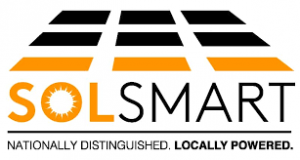 EcoMotion is partnering with the South Bay Cities Council of Governments to deliver the SolSmart program to eight cities. Our team is the only California team awarded through a national competitive solicitation.
EcoMotion is partnering with the South Bay Cities Council of Governments to deliver the SolSmart program to eight cities. Our team is the only California team awarded through a national competitive solicitation.
SolSmart is a program of The Solar Foundation, funded by the U.S. Department of Energy. The intent of the program is to promote municipal policies that advance solar power in our communities. This can happen through dozens of means, from streamline permitting, over the counter checks, no costs, by training inspectors… all to lower “soft costs.” Hard costs are simpler to define, the cost of panels, inverters balance of system contractor payments. Soft costs can be time related; they can be excessive transactional fees. The National Renewable Energy Laboratory (NREL) reports that soft costs are 64% of the cost of solar.

“EcoMotion and our cities are going for gold!” noted Shaun Miller, EcoMotion’s project manager. Given California laws… progressing through SolSmart’s Bronze, Silver, and Gold designation pathway will be possible. The cities involved are El Segundo, Rancho Palos Verdes, Torrance, Palos Verdes Estates, Gardena, Carson, Manhattan Beach, and Hawthorne. For each city, EcoMotion will evaluate current solar policies through municipal code reviews, checking for zoning inclusions and exclusions. EcoMotion will then conduct a gap analysis between current and best practices and will help the cities adopt new policies, programs, and initiatives that bring them up to speed with best practices, and hopefully… Gold SolSmart distinction.
One Million EVs and Counting!
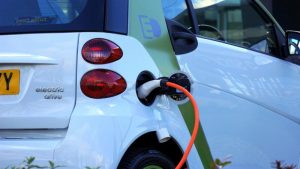 National EV sales have topped 1 million cars according to Veloz, a public-private coalition of major electric car industry stakeholders. Nationally, EVs have been about 1% of the market for the past two years, but 2018 changes that… nearly doubling the EVs sold. By April of this year, 1.74% of national light vehicle sales were EVs… a level expected to hit the 2% level by year end.
National EV sales have topped 1 million cars according to Veloz, a public-private coalition of major electric car industry stakeholders. Nationally, EVs have been about 1% of the market for the past two years, but 2018 changes that… nearly doubling the EVs sold. By April of this year, 1.74% of national light vehicle sales were EVs… a level expected to hit the 2% level by year end.
California’s EV market reached a record 7.7% in April and may be ~7.5% for the entire year. Tesla, alone, sold 4.6% of California vehicle sales in the third quarter. One half of national EV sales are in California. By November 2018, 512,717 EVs had been sold in California. According to California Energy Commission Commissioner David Hochschild, California is well on the way to its 5 million EV goal by 2030.
In related news, stay tuned for FreeWire Technologies, a mobile and stationary energy storage start-up. Its mobile battery systems grab power off peak, store it, and provide it to EVs to dramatically cut power costs. The FreeWire Mobi Charger systems provide EV charging without construction or permitting, taking only 110 volts of power.
Also related, Nio builds battery swap stations in China for electric vehicles. Nio has not abandoned the long-term option of swapping batteries. This young company aspires to build a sprawling network of swap stations in China, beginning by building a series of 18 swap stations along the G4 Expressway in China which runs 2,285 km north to south.
Travelogue: DC Reflections
 Visiting our capitol city with temperatures in the thirties, a strong wind chills us to the bone. We buy Metro tap cards and take transit from Dulles to DC. It’s dark by the time we get to the Kimpton Hotel at DuPont Circle. The next morning we wake early and hit the Kramerbooks Café.
Visiting our capitol city with temperatures in the thirties, a strong wind chills us to the bone. We buy Metro tap cards and take transit from Dulles to DC. It’s dark by the time we get to the Kimpton Hotel at DuPont Circle. The next morning we wake early and hit the Kramerbooks Café.
Fortified, Terry and I brave 32 degrees coupled with a strong wind that rips our California blood! It’s a classic blustery day with billowing clouds. We walk down Connecticut to the White House, past the clad African-American Museum, and circle the Washington Monument. Its ring of flags are taut… a steady wind ripping at full force.
It’s massive. When built in 1884, the Washington Monument at 555 feet was the tallest man-made structure in the world, early twice the height of the US Capitol. (The Burj Khalifa in Dubai is now the world’s tallest structure at 2,717 feet tall… more than five times the Washington Monument.) The Washington Monument is now closed for renovations… new elevators we’re told. I remember visiting DC as a kid and my brother Billy and I chasing each other up the stairs all the way to the top.
From there, we walk past the World War 2 memorial and along the reflecting pool to the Lincoln Monument. Those broad stairs, the hush in the Monument where we admire Lincoln, his poise, his set of perspective and philosophical power. Then the visit the Wall, leaves blown in a pile in its vortex. Leaves of fall in DC.
Uber to Capitol Hill, we marvel at the Supreme Court’s capitol-north prominence. The capitol is set up for visitors, to welcome us all to witness this remarkable place of power. There’s no charge to tour the capital. We join a queue, watch a video about E Pluribus Unum, and bask in the magnificence of the massive rotunda and its majesty.
The Solar Foundation invited EcoMotion to a training in Washington and I represented EcoMotion. Our project is one of a dozen awarded solar projects representing 108 cities. Our goal is to influence local government policy to address the number one barrier to solar – its high first cost – and inversely, to lower the soft costs of solar. EcoMotion partnered up with the South Bay Cities Council of Governments and won a SolSmart grant. Our project involves eight cities…. bringing their zoning, codes, permitting, inspection processes up to best-practice levels. We meet at the offices of the National Association of Counties near Union Station and are briefed by the Solar Energy Industries Association.
Later in the week we visit the Holocaust Museum. It’s grotesquely sobering and remarkably reflective. It put my problems in perspective quickly. The images nail me… grainy but real black and white videos of limp, naked bodies being bulldozed into mass graves. The display of one of the crematoriums of Auschwitz where Jews were forced to strip down for “showers” sickens me. We pass through piles of actual shoes that smell. Poignant. These are real problems… hate and hate and defiling one another.
What a pleasure to reconnect with three colleagues that I hadn’t seen for years: Mat Hastings and I were in strategic Planning at New York Power Authority right after grad school. We shared a meal and reflections. Russ and Michele Sturm welcomed us in their Bethesda home for an evening. I worked for Russ at the International Finance Corporation so many years ago when Russ headed up a four continent, seven-country lighting initiative. I managed the Philippines team. Greg Kats, one of my great friends from Rocky Mountain Institute, and I solved many of the world’s most pressing problems over coffee in Georgetown.

